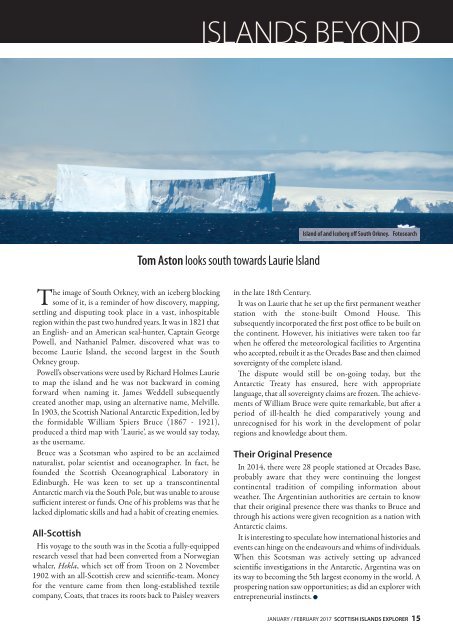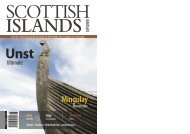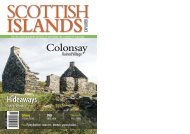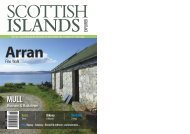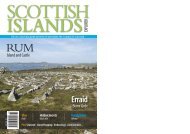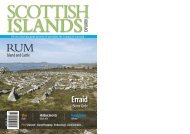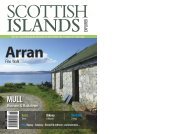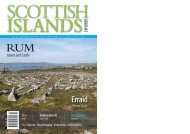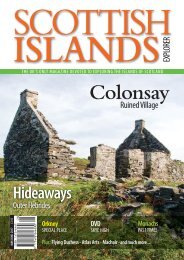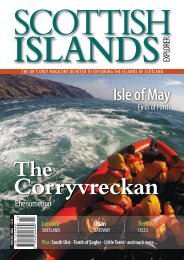You also want an ePaper? Increase the reach of your titles
YUMPU automatically turns print PDFs into web optimized ePapers that Google loves.
ISLANDS BEYOND<br />
Island of and Iceberg off South Orkney. Fotosearch<br />
Tom Aston looks south towards Laurie Island<br />
The image of South Orkney, with an iceberg blocking<br />
some of it, is a reminder of how discovery, mapping,<br />
settling and disputing took place in a vast, inhospitable<br />
region within the past two hundred years. It was in 1821 that<br />
an English- and an American seal-hunter, Captain George<br />
Powell, and Nathaniel Palmer, discovered what was to<br />
become Laurie Island, the second largest in the South<br />
Orkney group.<br />
Powell’s observations were used by Richard Holmes Laurie<br />
to map the island and he was not backward in coming<br />
forward when naming it. James Weddell subsequently<br />
created another map, using an alternative name, Melville.<br />
In 1903, the <strong>Scottish</strong> National Antarctic Expedition, led by<br />
the formidable William Spiers Bruce (1867 - 1921),<br />
produced a third map with ‘Laurie’, as we would say today,<br />
as the username.<br />
Bruce was a Scotsman who aspired to be an acclaimed<br />
naturalist, polar scientist and oceanographer. In fact, he<br />
founded the <strong>Scottish</strong> Oceanographical Laboratory in<br />
Edinburgh. He was keen to set up a transcontinental<br />
Antarctic march via the South Pole, but was unable to arouse<br />
sufficient interest or funds. One of his problems was that he<br />
lacked diplomatic skills and had a habit of creating enemies.<br />
All-<strong>Scottish</strong><br />
His voyage to the south was in the Scotia a fully-equipped<br />
research vessel that had been converted from a Norwegian<br />
whaler, Hekla, which set off from Troon on 2 November<br />
1902 with an all-<strong>Scottish</strong> crew and scientific-team. Money<br />
for the venture came from then long-established textile<br />
company, Coats, that traces its roots back to Paisley weavers<br />
in the late 18th Century.<br />
It was on Laurie that he set up the first permanent weather<br />
station with the stone-built Omond House. is<br />
subsequently incorporated the first post office to be built on<br />
the continent. However, his initiatives were taken too far<br />
when he offered the meteorological facilities to Argentina<br />
who accepted, rebuilt it as the Orcades Base and then claimed<br />
sovereignty of the complete island.<br />
e dispute would still be on-going today, but the<br />
Antarctic Treaty has ensured, here with appropriate<br />
language, that all sovereignty claims are frozen. e achievements<br />
of William Bruce were quite remarkable, but aer a<br />
period of ill-health he died comparatively young and<br />
unrecognised for his work in the development of polar<br />
regions and knowledge about them.<br />
Their Original Presence<br />
In 2014, there were 28 people stationed at Orcades Base,<br />
probably aware that they were continuing the longest<br />
continental tradition of compiling information about<br />
weather. e Argentinian authorities are certain to know<br />
that their original presence there was thanks to Bruce and<br />
through his actions were given recognition as a nation with<br />
Antarctic claims.<br />
It is interesting to speculate how international histories and<br />
events can hinge on the endeavours and whims of individuals.<br />
When this Scotsman was actively setting up advanced<br />
scientific investigations in the Antarctic, Argentina was on<br />
its way to becoming the 5th largest economy in the world. A<br />
prospering nation saw opportunities; as did an explorer with<br />
entrepreneurial instincts.<br />
JANUARY / FEBRUARY <strong>2017</strong> SCOTTISH ISLANDS EXPLORER 15


